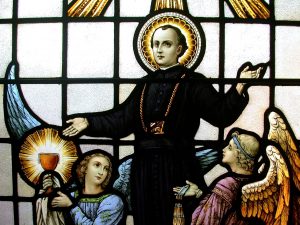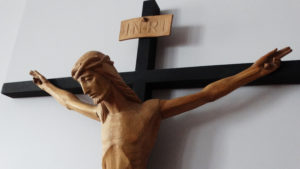By Fr. David Hoying, C.PP.S.
Before rereading several of the biographies of Gaspar, I was rather unaware of a prominent part of his ministry, the many wonders and miracles that blessed his life. What further struck me was Gaspar’s response to them. So routinely did they happen, that never did they disrupt his ministry. On these he never gloated. He accepted them as quiet but fruitful signs of his faithfulness to God’s will. More than wonders, other signs also witnessed to the fruitfulness of his ministry—great crowds, abundant penitents, surprising conversions and the lasting quality of his preaching.
 Most singular of Gaspar’s wonders was the event in Meldola in 1818. He was observed preaching before the church with crucifix in hand, while yet at the same time was seen in the confessional giving absolution. We ought not to dismiss Gaspar’s miracles as unimportant or to nuance them out of existence. Rather, we ought to take them at face value, and ask what are these miracles telling us, what lessons are in them for us Missionaries? Therefore, what does Gaspar’s bilocation—his preaching and absolving at the same time—tell us? Does it not speak of a relationship and an equality between the two? For Gaspar, preaching and confession so naturally went together. Do we find that same connection of the two in our own ministry?
Most singular of Gaspar’s wonders was the event in Meldola in 1818. He was observed preaching before the church with crucifix in hand, while yet at the same time was seen in the confessional giving absolution. We ought not to dismiss Gaspar’s miracles as unimportant or to nuance them out of existence. Rather, we ought to take them at face value, and ask what are these miracles telling us, what lessons are in them for us Missionaries? Therefore, what does Gaspar’s bilocation—his preaching and absolving at the same time—tell us? Does it not speak of a relationship and an equality between the two? For Gaspar, preaching and confession so naturally went together. Do we find that same connection of the two in our own ministry?
Gaspar was compelled by the Holy Spirit to preach the power of the Precious Blood—as he himself said, for this we are priests, “to apply the merits of the Divine Blood.” As well, he said, “I would like to draw every heart to the Precious Blood.” The end of Gaspar’s preaching was the conversion of sinners and having them “be purified by the blood of redemption.”
Drawn to the Truth of Jesus
Gaspar’s zeal embodied his love for Jesus and his truth. Gaspar was so convicted in his love for Jesus and his Precious Blood, that when he preached, he spoke with such compassion and devotion that those who heard were as well convicted. They were struck and drawn to the truth of Jesus, the acceptance of which brought them to conversion. Always, the sacrament of penance was a pillar of his missions. It was, as well, an important ministry of the mission house, to which Gaspar said the missionaries were to assiduously apply themselves.
Confession was the absolute and necessary corollary to preaching. Preaching was the cause and confession the effect. Confession was always the fruit of Gaspar’s preaching. They were a dynamic duo that was inseparable. Spinelli relates that Gaspar saw all the sacraments, especially confession, as founded on the Precious Blood. St. Gaspar says that in this sacrament there is verified that being “justified in the blood, we will be saved by it from wrath.” And, he further states. “O what great work we will accomplish, my beloved in Jesus Christ. O Souls, come and cleanse yourselves in the Blood of the Lamb.”
Our modern sensibilities do not take to this truth too readily. After all, it is all just too spiritual, and who yet makes use of this antiquated sacrament? But, is there not a more serious reality than sin that calls out for reconciliation?
The Intersection of Two Beams
 Central to Gaspar’s message is the cross, the fruit of which is the Precious Blood. The cross is formed by the intersection of two beams—one vertical, the other horizontal. The horizontal beam is most appealing to us. This beam concerns all the realities of the world and ourselves, of their interconnectedness in the here and now, and how the Precious Blood impacts that reality. Thus, we think in terms of social, economic, emotional, mental, political and sexual peripheries or edges of reality. The vertical beam concerns the necessary connection between God and us and would concern those on the spiritual periphery or sinners. For the cross to be the cross, both beams are necessary, or it is not the cross. Both are necessary to our ministry or we are not preaching the cross.
Central to Gaspar’s message is the cross, the fruit of which is the Precious Blood. The cross is formed by the intersection of two beams—one vertical, the other horizontal. The horizontal beam is most appealing to us. This beam concerns all the realities of the world and ourselves, of their interconnectedness in the here and now, and how the Precious Blood impacts that reality. Thus, we think in terms of social, economic, emotional, mental, political and sexual peripheries or edges of reality. The vertical beam concerns the necessary connection between God and us and would concern those on the spiritual periphery or sinners. For the cross to be the cross, both beams are necessary, or it is not the cross. Both are necessary to our ministry or we are not preaching the cross.
It seems that we are backing away from the vertical beam. It may be that this beam concerns a more difficult ministry, and less noteworthy one as it is often hidden. The horizontal beam may concern an easier ministry, and a more noteworthy one because it is out there calling attention to itself and to us. The vertical beam involves a vital relationship with God in which there is a surrender of ourselves to God, of losing ourselves in him. With the horizontal beam we must be aware of a danger to confuse our work with God’s work.
Of the two beams, the vertical is the more necessary, for on what is the horizontal to be attached to make of them a cross? Thus, we ought to be emphasizing the vertical, the spiritual dimension and the effect of the Precious Blood upon it. The reasserting of this spiritual dimension might prove attractive for vocations. If love for Jesus and his Precious Blood was so earnest for Gaspar as to cause his bilocation, might not our earnestness for the same bring new Gaspars to life?
Looking for a Real Cure
The most stunning of Gaspar’s achievements was the reconciliation of the banditti at Sonnino. Whatever were the visible dire realities of their situation, we cannot overlook the truth that at the root of their situation was a spiritual malady. What did Gaspar preach to them? Nothing but the Precious Blood of Jesus! What was the fruit of that preaching? It was their conversion! How was this reconciliation wrought? It was through sacrament of confession alone!
When facing the problems of the horizontal peripheries, can we not see that at their beginnings are spiritual deformities, which are of the spiritual periphery? We cannot remedy the problems by only treating the symptoms; we must go for a cure at its roots. Patching up the wounds without treating the underlying infection will only allow it to ravage the heart. The lack of spiritual healing will always cause problems to fester. If we are not right with God, how can anything else be right? Confession must therefore be the companion of our preaching. Applying the mercy generated by the Precious Blood to each heart through absolution is the supreme means of reconciliation.

Fr. John Kalicky, C.PP.S., at St. John the Baptist Church in Whiting, Ind.
In the hospital of mercy, the confessional is the operating room, where heart surgery is done, where the mercy of God is applied to souls; and it is also the room for transfusions, transfusions with the Precious Blood whereby the dead are raised to new life and eternal life is engendered.
We can do nothing less than Gaspar himself with our preaching of the power of the Precious Blood, that we celebrate that power in the sacrament of penance. Are we not Missionaries to apply the merits of the Precious Blood? In our prayers to Gaspar, let us ask that we can fulfill the mission God gave to him, to save and sanctify a myriad of souls.
(This is the text of a homily delivered by Fr. Hoying on St. Gaspar’s feast day celebration at St. Charles Center, Carthagena, Ohio, in October 2019.)
